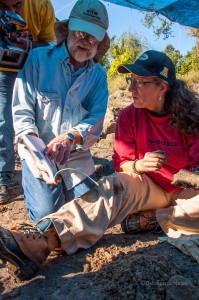More Than Bones Tell The Story

Dave Brenzel of the Indian Creek Nature Center, left, talks to Jen Winfrey about the recent discovery that was just unearthed.
Oskaloosa, Iowa – The digging continues at the Mahaska Mammoth location, and scientists continue to learn more about Iowa and its history.
Scientists are learning more about the environment, not only from the preserved vegetation such as pollen, pine needles, spruce logs and other organic material, but also the silt layers left behind.
The ancient pool where the mammoths have collected is also yielding periods of fast water and slow water that made its way down the river bed at that time over fourteen-thousand years ago.
Volunteers were working to expose those layers on Saturday, cutting a straight wall down so it could be photographed and analyzed. Adding all the clues up, sediment, organic material and the bones, helps to give researchers the big picture.
One of those volunteers who is continuing the work of uncovering more bones is Jen Winfrey, who is a member and outgoing president of the science club at Indian Hills Community College in Ottumwa.
In her second year of digging at the location, Winfrey has seen the site progress from its initial stages, as a small site, to what it has progressed to today, a site with multiple areas teaming with information. “We’ve come so far. We’ve found large bones, we’ve found small bones… and of course the tusks were like an ah-ha moment for everybody. Every little bit that gives a little bit more answer to this piece; Why were they here? What did they eat? All these questions we want answered. Every little piece is part of that puzzle.”
On Saturday, Winfrey helped to locate and extract a zygomatic arch from what is believed to be one of the adult mammoths. The zygomatic arch is basically your cheek bone. “Kind of an interesting find today,” says Winfrey. “Any find is exciting at this point.”
The rumor around the dig site is that there could possibly be a fourth mammoth at the location, but further testing of some excavated teeth is necessary before there can be any confirmation. That potential fourth mammoth would then join the, what’s believed, adult male and female, along with a juvenile mammoth.















